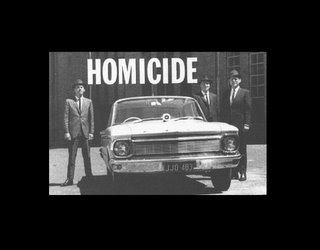
Went last night to a presentation related to an exhibition currently showing at the Justice & Police Museum ... haven't managed to penetrate the security at the Museum and see the show yet, though I've tried, haven't brought the book that goes with the show either, I've just been monitoring the publicity thus far; this was the first chance I had to see some images in a decent format. It was extraordinary.
A few years ago someone found out that there was, stored in a warehouse in Lidcombe, a complete set of photographic negatives taken by police photographers over a period of about six decades. These had somehow become detached from the case notes or crime reports that they illustrated, which have since disappeared, so it is in many cases impossible to discover exactly what or who or where had been photographed and why, increasing the mysterious aura that surrounds many of these images.
The early negatives are on glass plates or on acetate. Crime writer Peter Doyle, who delivered the presentation, has spent years going through some of the ten thousand or so that survive. About three hundred are in the exhibition; one hundred and seventy odd in the handsome book that accompanies it; of the rest, Peter reckons at least three thousand are just as good as those he chose to represent. It is a social cache of unparalleled richness. And this refers only to those that come from the period 1912-48.
It was from this cache that he drew the images he projected last night. He's a relaxed and witty guy, extremely locally knowledgeable about inner city Sydney and he'd had the bright idea of using pictures that had been taken in the immediate environs of where we were, Gleebooks in Glebe Point Road. This meant plenty of people in the audience recognised places he showed and, remarkably, that some could even add information to what was already known.
For instance there were a couple of shots of the small park in the churchyard opposite the old Gleebooks, near the corner of St. Johns Road. Peter thought they represented a murder scene but he didn't know for sure. However, a woman in the audience noticed a gate leading from the park into the churchyard and that tweaked a memory she had of a conversation with a 91 year old local woman who lives in the retirement home behind the church. She'd been asking why there wasn't a gate into the churchyard. The old lady said there was, but they took it away after a murder in the park. We all looked at that gate, half hidden under dark bushes, with an undefined but unmistakable menace in the air.
These were beautifully composed and technically superb photographs. Black and white, natch. Stark, eerie, monumental, grim, tragic, fantastic, haunting. The street scenes particularly. And the portraits. Peter offered a possible explanation for their perceived high aesthetic quality. He suggested that the deliberate choice of directors and cinematographers who made the noir films of the 1940s to imitate the conventions of police photography might account for our response to these images. Retrospectively investing them with qualities aestheticized by Hollywood in the '40's in other words. Interesting suggestion, which he did not insist upon.
He also remarked that police photography between the wars attracted young tyros of the kind who perhaps go into IT these days. Young, hungry, talented go-getters who were at the cutting edge of the art/craft. Someone else pointed out how many times the photographer will compose the photograph so as to catch his or her own image somewhere in the picture: in the round of a hubcap, or a mirrored in a window. These self portraits are always faceless. I just thought the images had been made with skill, passion and a sophistication we sometimes deny the past at the same time as we inflate it in ourselves.
I didn't know that the old Sydney morgue was up at the Rocks, where the Tourist Help Centre is now (ha!). Peter said this morgue wasn't the kind of sanitized place we see on CSI, all bright lights and stainless steel. No, he said, it had in fact a slatted wooden floor, with quite wide gaps between the boards, and in those gaps pieces of viscera or flesh or bone or whatever got caught and there they stayed. The smell was indescribable. A woman sitting just in front of me popped up her hand then. She'd worked in the Justice Department in the 1950s and 1960s and remembered how newly appointed magistrates were always given a tour of the morgue. It was a rite of passage. Oh, Sydney ...
I could go on ... but I won't. One final, astonishing, image. It was of a human skull, with the cap sawn off - expertly trepanned. Inside was what looked like a dried brain, but oddly angular, not the round folds and curls of grey or white matter. What on earth ... ? Peter explained the skull had been exhumed for forensic purposes and inside they had found ... a white ant nest.

